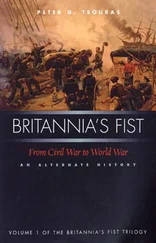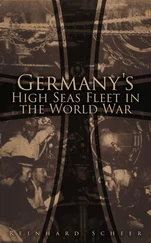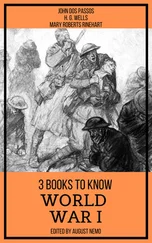About a hundred yards away from them the wood ended in a long point consisting of small scattered trees about ten or fifteen feet high. Suddenly the tank nearest to these made towards them. She glided very quickly up to the wood. We thought she was going through it, and wondered what would happen when she exposed herself to the direct view of the German guns which we knew were in that valley. A shell burst about thirty yards from the side of her◦— very likely it was one of our own for she was right up to the barrage line.
And then a wonderful thing happened. The tank which had been gliding forward suddenly stopped dead. We could scarcely believe our eyes when the next second she was gliding backwards as fast as she had slipped forward. She retreated for twenty yards like a shunting train. Then she instantly slid forward again to about the same position & stayed there.
We thought she must be dodging shells as we had seen one poor old tank try to do in an earlier battle; it was an old make, one of the first that were made, and it was far too slow & the guns simply played with it as a cat plays with a mouse. The modern ones are very fast to what the old tanks were & the newer ones have some chance we thought. But when she stopped & only one man got out of her and walked back from her it looked as if she too had been finished.
Ten minutes later we looked again and she was gone. Later we heard that the men we had seen here were a company of American infantry. As they were getting their bearings a machine gunner in the corner of the wood shot two of their officers dead. The tank at once made for this machine gun post & ran straight over it twice & then took up her position there to cover the Americans till they had dug in. She captured herself several prisoners so we were told.
By this time at least one tank and men also were not merely up to, but beyond the wood of Accroche. They had gone on through our own barrage, for our own shells were falling far behind them. There were many tanks visible at this period against the skyline or the smoke from our barrage. There were long lines of men digging around and along almost the whole front. Later the tanks withdrew.
Amiens and the Hundred Days
The Allied offensive that began on 8 August 1918 transformed the stagnation of trench warfare on the Western Front to a war of mobility and movement. The Germans had pre-empted this in their Spring Offensive of March 1918, but had met resolute defence, gradually augmented by an increasing American presence. In addition, lack of reserves prevented the Germans maintaining the momentum of their initial successes.
By August the American reinforcement had become significant, and was continuing to build. British tank forces were also expanding, and their units were now equipped with the Mark V tanks that had been so successful at Hamel.
One of the battles fought by Australians with tank support in the Hundred Days is of particular interest. Iven Mackay commanded the 1st Australian Infantry Brigade in the battle of Chuignolles on 23 August 1918. He later became one of the Army’s senior World War II commanders.
By the end of the battle, all the objectives, including areas beyond Chuignolles, had been captured. A significant factor in the success was the excellent cooperation between the Australian infantry and the British tanks. In the aftermath of the attack, Brigadier Mackay called his battalion commanders together to discuss their first acquaintance with the battle tank, in the course of which he made these points:
Although many became casualties, great help was given to the infantry, again proving that the tank when well supported by the infantry is an invention much dreaded by the enemy. Since some were knocked out and the country was open, the tanks did not participate in the second stage of the attack. Those that attempted to climb a ridge north-east of Chuignolles found it too steep.
Tanks are most useful at the beginning of an attack when they have a great moral effect. When the attack is well launched they have done their main work. The infantry, once landed at its objective, should be able to defend itself. Tanks patrolling in daylight will inevitably be hit. Too much should not be asked of them, and before they become casualties they should be withdrawn for future use. 31
These comments form a realistic evaluation of the performance of the Mark V tank. Early in World War II, Mackay commanded the 6th Australian Infantry Division. In the division’s first major action, the capture of Bardia, Mackay made excellent use of the tanks under his command, the Matildas of the 7th Royal Tank Regiment.
Chapter 3:
A LONG SLEEP AND TWO WAKE-UP CALLS

The long sleep, 1918 to 1939
As soon as the 1914–18 war ended, the armed forces of the victorious nations were rapidly and drastically reduced in size. The Armistice of 11 November 1918 came more quickly than many had expected, and mechanisms for demobilisation and disposal of war materiel took some time to become fully effective. It was thus several months before attention could be given to the role, composition and equipment of the armies that would be needed in peacetime.
The British Army had been foremost in developing and implementing the use of tanks and, in the second half of 1918, had been planning a significant expansion of its tank forces. This expansion was not limited to size and also included broadening the role of the tank. The success of the few Whippets 1that had been in action had led military thinkers such as Fuller to envisage tanks as the major component of a strong mobile strike force. 2
The Armistice stymied these plans. When the British Army began to reorganise for peacetime there were many in the High Command who considered that tanks had fulfilled their wartime role and were no longer required. It was unlikely that there would be a recurrence of trench warfare and tanks had been produced primarily to help the infantry advance through wire defences and across trenches.
During the Hundred Days that marked the final stage of the war, tanks had supported the infantry very successfully in set-piece attacks, but were less successful in the mobile warfare that became more prevalent. The Mark Vs were geared to working at infantry pace and the faster tanks were in short supply or under development. Additionally, the strain of continual movement over the Hundred Days made it very difficult to keep the tanks and crews fit for action. A report from 5 Tank Brigade to Tank Corps HQ on crew endurance explained that:
[Crew endurance] depends entirely on the conditions of weather, ground, state of engine and intensity of fighting. When a tank is in good condition with a new engine, favourable weather, not exposed to intense hostile shelling or very severe fighting the crew may be counted on for 12 hours in action after leaving the line of deployment.
The average time is about 8 hours, but very hot weather, hard fighting, and engines requiring overhaul considerably lessen this period. In the action of 23 August some crews were physically ill after 2 hours’ fighting. The tanks had done a bit of running and it had been impossible to overhaul the engines. Consequently the exhaust had warped and joints became loose, and the tank was full of petrol fumes. Three men were sent to hospital, one of them in a critical condition. 3
The view that tanks would not be needed again was forcefully put by Major General Sir Louis Jackson, Director of Trench Warfare and Supplies at the Ministry of Munitions from 1915 to 1918, in a paper given to the Royal United Services Institute on 17 December 1919. Jackson commented that ‘The tank proper was a freak, the circumstances which called it into existence were exceptional and not likely to recur. If they do they can be dealt with by other means.’ 4
Читать дальше













